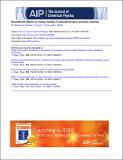Geometrical effects on energy transfer in disordered open quantum systems
Author(s)
Shabani, A.; Omar, Yasser; Rabitz, H.; Mohseni, Masoud; Lloyd, Seth
DownloadLloyd_Geometrical effects.pdf (1.988Mb)
PUBLISHER_CC
Publisher with Creative Commons License
Creative Commons Attribution
Terms of use
Metadata
Show full item recordAbstract
We explore various design principles for efficient excitation energy transport in complex quantum systems. We investigate energy transfer efficiency in randomly disordered geometries consisting of up to 20 chromophores to explore spatial and spectral properties of small natural/artificial Light-Harvesting Complexes (LHC). We find significant statistical correlations among highly efficient random structures with respect to ground state properties, excitonic energy gaps, multichromophoric spatial connectivity, and path strengths. These correlations can even exist beyond the optimal regime of environment-assisted quantum transport. For random configurations embedded in spatial dimensions of 30 Å or 50 Å, we observe that the transport efficiency saturates to its maximum value if the systems contain around 7 or 14 chromophores, respectively. Remarkably, these optimum values coincide with the number of chlorophylls in the Fenna-Matthews-Olson protein complex and LHC II monomers, respectively, suggesting a potential natural optimization with respect to chromophoric density.
Date issued
2013-05Department
Massachusetts Institute of Technology. Department of Mechanical Engineering; Massachusetts Institute of Technology. Research Laboratory of ElectronicsJournal
The Journal of Chemical Physics
Publisher
American Institute of Physics (AIP)
Citation
Mohseni, M., A. Shabani, S. Lloyd, Y. Omar, and H. Rabitz. “Geometrical Effects on Energy Transfer in Disordered Open Quantum Systems.” The Journal of Chemical Physics 138, no. 20 (2013): 204309.
Version: Final published version
ISSN
00219606
1089-7690